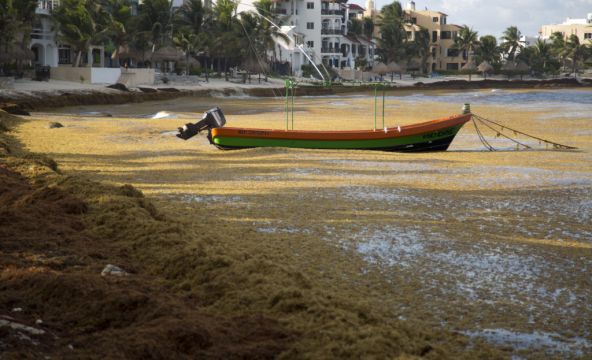Mexican authorities have said the problem of foul-smelling sargassum – a seaweed-like algae – on the country’s Caribbean coast beaches is “alarming”.
The arrival of heaps of brown, foul-smelling sargassum on the coast’s normally pristine white sand beaches comes just as tourism is recovering to pre-pandemic levels, though job recovery in the country’s top tourist destination has been slower.
With more algae spotted floating out at sea, experts fear that 2022 could be as bad or worse than the catastrophic year of 2018, the biggest sargassum wave to date.
“We can say the current situation is alarming,” said navy secretary Jose Ojeda, who has been entrusted with the apparently hopeless task of trying to gather sargassum at sea, before it hits the beaches.
The navy currently has 11 sargassum-collecting boats operating in the area. But the navy’s own figures show that the portion they have been able to collect before it hits the beach has been falling.
In 2020, the navy collected 4% of sargassum at sea, while 96% was raked off beaches. But that figure fell to 3% in 2021, and about 1% so far in 2022.
Allowing the algae to reach the beaches creates not only a problem for tourists, but for the environment, said Rosa Rodriguez Martinez, a biologist in the beachside town of Puerto Morelos who studies reefs and coastal ecosystems for Mexico’s National Autonomous University.
So much algae is reaching the beaches that hotels and local authorities are using bulldozers, because the normal teams of rakes, shovels and wheelbarrows are no longer enough.
“The heavy machinery, when it picks it (sargassum) up, takes a large amount of sand with it, contributing to beach erosion,” said Ms Rodriguez Martinez.
“There is so much sargassum that you can’t use small-scale equipment anymore, you have to use the heavy stuff, and when the excavators come in, they remove more sand.”
Ms Rodriguez Martinez worries that 2022 could be worse than 2018, the previous peak year.
“In the last few days there have been amounts washing up, and in places, that I didn’t see even in 2018,” she said.
Ms Rodríguez Martinez is already suffering the effects herself, at her beachside offices.
“Where I am, I’m about 50 metres from the beach and the smell is very unpleasant,” she said. “Right now my head is hurting and another friend said her head hurts.”
The problem comes just as resorts such as Cancun, Playa del Carmen and Tulm are recovering from the brutal two-year drop in tourism caused by the coronavirus pandemic.
Not all beaches have been hit equally; many in Cancun and Isla Mujeres are often free of much sargassum, but much of the Riveria Maya has been hit hard.
Carlos Joaquin, governor of the coastal state of Quintana Roo, said the number of tourists arriving by air so far this year- some 3.54 million travellers — is 1.27% above 2019 levels, before the pandemic. But Mr Joaquin said that only about 83% of the 98,000 jobs lost during the pandemic have returned.
Sergio Leon, the former head of the state’s employers’ federation, said the seaweed invasion “has definitely affected us, it has affected our image on the domestic and international level. Obviously, not just visually, but in term of environmental damage and pain”.
“The Navy is making an effort, but it needs more, it isn’t enough,” said Mr Leon. “The ideal thing would be to gather it before it gets to our beaches.”
Ms Rodriguez Martinez said that, given the limited number of navy boats and funds, the best solution might be to hang floating offshore barriers and collect the sargassum in waters closer to the shore.







